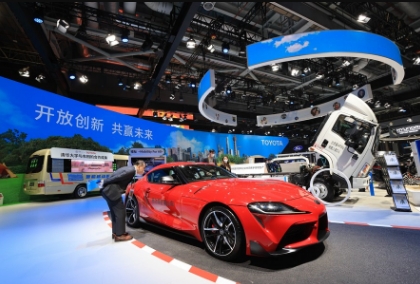China's broader opening-up brings vitality to global development

A visitor looks at a car at the booth of Toyota at the fifth China International Import Expo (CIIE) in east China's Shanghai, Nov. 6, 2022. (Xinhua/Li Jing)
China has been walking the talk of high-standard opening-up, with concrete moves that will allow economies worldwide to benefit.
China reaffirmed on Friday that it will advance a broader agenda of opening-up across more areas and with greater depth, follow the Chinese path to modernization, put in place new systems for a higher-standard open economy, and continue to share the nation's development opportunities with the world.
In one of its most recent efforts to that end, the country has opened more sectors to foreign investment, with its new catalog of industries in which foreign investment will be encouraged. The revision, with 239 new items added and 167 existing ones modified, places special focus on the manufacturing sector and producer services.
In opening the financial market, China has also allowed eligible overseas institutional investors to invest directly or through connectivity in the exchange bond market from June 30.
Backed by these endeavors, China has retained its strong appeal to foreign businesses despite gloomy investment sentiment around the globe. Foreign direct investment (FDI) in the Chinese mainland, in actual use, went up 17.4 percent year on year to 168.34 billion U.S. dollars in the first 10 months, official data shows.
The country has also fostered cross-border trade of products and services through regular global events, including the China International Import Expo (CIIE) and the China International Fair for Trade in Services.
The fifth CIIE, held from Nov. 5 to Nov. 10, saw a total of 73.5 billion U.S. dollars' worth of tentative deals reached for one-year purchases of goods and services. The figure represents an increase of 3.9 percent from that of last year.
The sixth China-South Asia Exposition, which opened on Saturday in Kunming, capital of southwest China's Yunnan Province, is another platform for China to work with all countries to create more growth drivers in cooperation, advance the high-quality development of the Belt and Road cooperation and implement the Global Development Initiative, so as to build a more prosperous and brighter future together.
The country's foreign trade in goods with countries and regions participating in the Belt and Road Initiative posted robust year-on-year growth, with both exports and imports jumping over 20 percent, official data shows.
Many landmark projects are now creating new growth drivers for economies along the Belt and Road. The Jakarta-Bandung High-Speed Railway, connecting Indonesia's capital Jakarta and its fourth-largest city Bandung, completed a successful trial operation on Nov. 16. It will cut the journey between the two cities from over three hours to around 40 minutes.
A World Bank report has predicted that the Belt and Road Initiative could, by 2030, help lift 7.6 million people out of extreme poverty and 32 million people out of moderate poverty globally. It will also help increase incomes by 0.7 percent globally.
In the near future, China will work with other parties on the full and high-quality implementation of the Regional Comprehensive Economic Partnership, and continue working toward joining the Comprehensive and Progressive Agreement for Trans-Pacific Partnership and the Digital Economy Partnership Agreement.
It will also consider holding the third Belt and Road Forum for International Cooperation next year to provide fresh impetus for the development and prosperity of the Asia-Pacific and the world.
"A more open China will bring about greater progress and prosperity to both itself and the world," said Cui Fan, a professor at the University of International Business and Economics.
Editor:黄鑫
